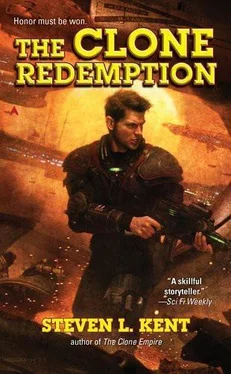Steven Kent - The Clone Redemption
Здесь есть возможность читать онлайн «Steven Kent - The Clone Redemption» весь текст электронной книги совершенно бесплатно (целиком полную версию без сокращений). В некоторых случаях можно слушать аудио, скачать через торрент в формате fb2 и присутствует краткое содержание. Жанр: Боевая фантастика, на английском языке. Описание произведения, (предисловие) а так же отзывы посетителей доступны на портале библиотеки ЛибКат.
- Название:The Clone Redemption
- Автор:
- Жанр:
- Год:неизвестен
- ISBN:нет данных
- Рейтинг книги:4 / 5. Голосов: 1
-
Избранное:Добавить в избранное
- Отзывы:
-
Ваша оценка:
- 80
- 1
- 2
- 3
- 4
- 5
The Clone Redemption: краткое содержание, описание и аннотация
Предлагаем к чтению аннотацию, описание, краткое содержание или предисловие (зависит от того, что написал сам автор книги «The Clone Redemption»). Если вы не нашли необходимую информацию о книге — напишите в комментариях, мы постараемся отыскать её.
The Clone Redemption — читать онлайн бесплатно полную книгу (весь текст) целиком
Ниже представлен текст книги, разбитый по страницам. Система сохранения места последней прочитанной страницы, позволяет с удобством читать онлайн бесплатно книгу «The Clone Redemption», без необходимости каждый раз заново искать на чём Вы остановились. Поставьте закладку, и сможете в любой момент перейти на страницу, на которой закончили чтение.
Интервал:
Закладка:
Unlike other synthetics, the SEALs knew that they were clones. They knew they were ugly and were deeply ashamed of it. The Japanese made jokes about their having the faces of bats or dragons or demons. Not wanting to embarrass the Japanese, the SEALs pretended not to understand them; but in their hearts, they agreed.
“Board your caskets,” Illych told his men.
The caskets were “stealth infiltration pods” or “S.I.P.s,” coffin-sized people-fliers designed to evade all known forms of detection. Six feet long and three feet wide, S.I.P.s could travel millions of miles in an hour. They scanned for radar, sonar, and laser detection and camouflaged their own footprint. They did not have guns or steering controls. SEALs did not pilot their caskets, they went along for the ride. Trapped in tubes so tight they could do no more than breathe, the SEALs did not become claustrophobic. It was not in their programming.
Seemingly designed to make passengers uncomfortable, the cargo pit of the S.I.P. lacked so much as a shred of padding, had no lights, and no communications gear. The S.I.P. was designed for ten-minute flights and nothing longer. Natural-borns could not tolerate even ten minutes in an S.I.P., but it never occurred to Illych and his SEALs that their S.I.P.s were uncomfortable.
The launching device at the back of the transport did not simply release the pods into space; it fired them like a high-powered rifle using supermagnetism. Once launched, the pod controlled the flight itself, using a field-resonance engine that operated as silently as a gentle breeze and as untrackably as one particular raindrop in a storm.
Field-resonance engines offered one other advantage. In theory, overcharging the engine of an S.I.P. triggered a reactive explosion that would measure in the millions of megatons. These were more than bombs; they were planet colliders.
A team of technicians opened the pods and the SEALs climbed into their caskets without hesitation. Once the technicians closed the pod doors, dry gel oozed in around the SEALs to protect them against the stresses of extreme acceleration and deceleration.
Working as quickly as they could, technicians dressed in soft-shelled armor lifted the S.I.P.s into place. The launching device had a revolving carriage with chambers for twelve caskets that the techs loaded like bullets.
The transport had been specially equipped with a stealth generator. Sitting only five hundred thousand miles outside the planet’s atmosphere, cloaked by the generator, the little ship was invisible, even to the Japanese Fleet. The pilot purged the air from the kettle, then he shut off the engines and all of the lights as he opened the rear hatch. This was the mission’s most vulnerable moment. With the hatch open, and the S.I.P.s in place, the stealth generator could no longer hide the transport.
Per special orders given them by Admiral Yamashiro, the sailors raised a hand in salute and shouted BANZAI as the device fired each pod into space.
The SEALs did not hear their cheers. InterLink transmissions did not penetrate the walls of their pods. For the duration of their flight, the SEALs heard nothing more than the sound of their own breathing as they streaked through space. Barely larger than old-fashioned space suits, the pods carried their cargo a half million miles in a matter of seconds.
In the history of mankind, no human had ever traveled so far in such a small vessel. Tasked with saving humanity, the SEALs went to space with equipment that Congress had previously labeled “too expensive to be practical.” Concerns about practicality vanished when it came to saving the human race.
It cost approximately eighty million dollars to build a stealth infiltration pod. The SEALs had brought five thousand of them to Bode’s Galaxy.
The pods traveled from the transport to the planet at top speed and did not slow until they pierced the atmosphere, leaving no more traces of their entry than needles slicing steam. Invisible to radar, sonar, and visual contact, the pods continued their computer-controlled deceleration until they touched down at the preappointed target as gently as autumn leaves landing in a grassy field.
All twelve pods landed within a forty-foot radius, their cargo bay doors opened, and the SEALs emerged. This was the first time man had set foot on a planet outside the Milky Way, a benchmark that meant nothing to Emerson Illych and his men. They had not come to explore. They had come to destroy.
Illych and his team knew what to expect. This planet was known as “A-361-F,” as it was the sixth planet from the star labeled “A-361.” A-361-F had an unbreathable atmosphere—a toxic cocktail of nitrogen, carbon monoxide, and methane. Because it was so far from the sun, a foot-thick layer of poisonous frost covered its surface. Had they not been wearing atmosphere-adjusting combat armor, the SEALs would have frozen to death before they got a chance to die of asphyxiation.
Illych thought the planet looked a lot like Earth’s moon might have looked had it been frozen under ice. Nothing had color. The ground was gray. The sky was black. The SEALs had landed during the period that passed for day, but the sun was four billion miles away, and day on A-361-F looked a lot like night.
The SEALs did not waste time chatting about the dreary surroundings. They quietly checked to make sure they had not left gear in their pods and began their mission.
In the hours before the mission began, remote surveillance technicians had used satellite drones to map the planet. Designed for military use, the satellites were not equipped to take air samples from space. They tested for radiation, located nonnatural structures, recorded ground movement, and searched for possible targets. On this planet, the satellites found only one point of interest, an abandoned building complex.
Looking at the satellite reports, Yamashiro’s intelligence officers said that complex was “inactive,” possibly an abandoned fort or a fueling station for space travelers. They had no way of knowing if it belonged to the Avatari, the aliens who had created such havoc upon the Milky Way. The author of the report did speculate that the enormous cylindrical structures along one face of the complex might be storage silos, suggesting that the facility might have been used as a fuel refinery.
The land around the complex was completely flat, no hills or craters. A labyrinth of tunnels and trenches might have been hiding beneath the foot-thick frost; but if so, it was invisible to the recon satellites. To Illych’s eyes, the plain had no notable features except for the buildings.
Illych did not bother telling his men what to do, they already knew their assigned duties. The SEALs had trained together since the day of their manufacture, twelve years earlier. They knew their objectives and performed their duties.
The SEALs divided into three four-man reconnaissance teams. Illych led his team toward the complex itself. If the buildings had had walls, doors, or windows, the master chief and his men would have searched from outside, looking for guards or security equipment. No doors, no walls, no roof. More than anything else, the place was a tangle of pipes and chambers. Inch-thick frost had formed on the structure, creating gray camouflage over the jet-black metallic surfaces below.
The building stood no more than fifty feet tall, built on an open-faced foundation. Using the thermal lenses in his visor, Illych scanned the area for heat signatures. He found nothing. Either the structure was out of use, or the material flowing through the pipes was of a type that could not be frozen.
Illych and his team looked for signs of the Avatari. They searched the platform for doors and compartments, using the sonar and X-ray equipment in their helmets; then they used the enhanced handheld equipment that they had brought with them. The pipes and chambers were hollow, the foundation and the ground around it were solid.
Читать дальшеИнтервал:
Закладка:
Похожие книги на «The Clone Redemption»
Представляем Вашему вниманию похожие книги на «The Clone Redemption» списком для выбора. Мы отобрали схожую по названию и смыслу литературу в надежде предоставить читателям больше вариантов отыскать новые, интересные, ещё непрочитанные произведения.
Обсуждение, отзывы о книге «The Clone Redemption» и просто собственные мнения читателей. Оставьте ваши комментарии, напишите, что Вы думаете о произведении, его смысле или главных героях. Укажите что конкретно понравилось, а что нет, и почему Вы так считаете.












